We’re in Darwin at the height of the rainy season. The heat and humidity is staggering, and even on a sunny day you can hear the sound of distant thunder.
Eventually our discomfort is relieved with a cloudburst. The intensity of tropical storms in Darwin has been spectacular. Loud claps and booms rattle doors and windows. They even shake buildings, earthquake-like at times. We’ve already sacrificed one modem to a furious thunderclap, and we wouldn’t be surprised by future casualties.
 Darwin reminds me of Alaska. It’s a weird connection to make, these tropical oceanside flats with frozen fjords and soaring mountains. But Darwinians (Darwinites?) have the same no nonsense approach to communication and life in general as Alaskans do. An Australian friend concurred: “It really is the last frontier. Anything past Darwin is Asia.”
Darwin reminds me of Alaska. It’s a weird connection to make, these tropical oceanside flats with frozen fjords and soaring mountains. But Darwinians (Darwinites?) have the same no nonsense approach to communication and life in general as Alaskans do. An Australian friend concurred: “It really is the last frontier. Anything past Darwin is Asia.”
While Darwin may not be as remote as Perth in terms of miles or oceans to cross, there are great distances that span between the Northern Territory and the more populated parts of Australia in the southeast. Just like Alaska feels by comparison with the Lower 48, Darwin’s an outpost.
Here in the Parap neighborhood, we’re about ten minutes’ stroll from Fannie Bay. Pete has been bonding with the little dog we’re watching during long walks on the beach. The view of the bay is sweeping, occasionally punctuated with a ship or two. It’s pleasant and quiet, with an inner-ring suburban vibe. The main city skyline lies on the horizon, insulated in a mist of humidity.
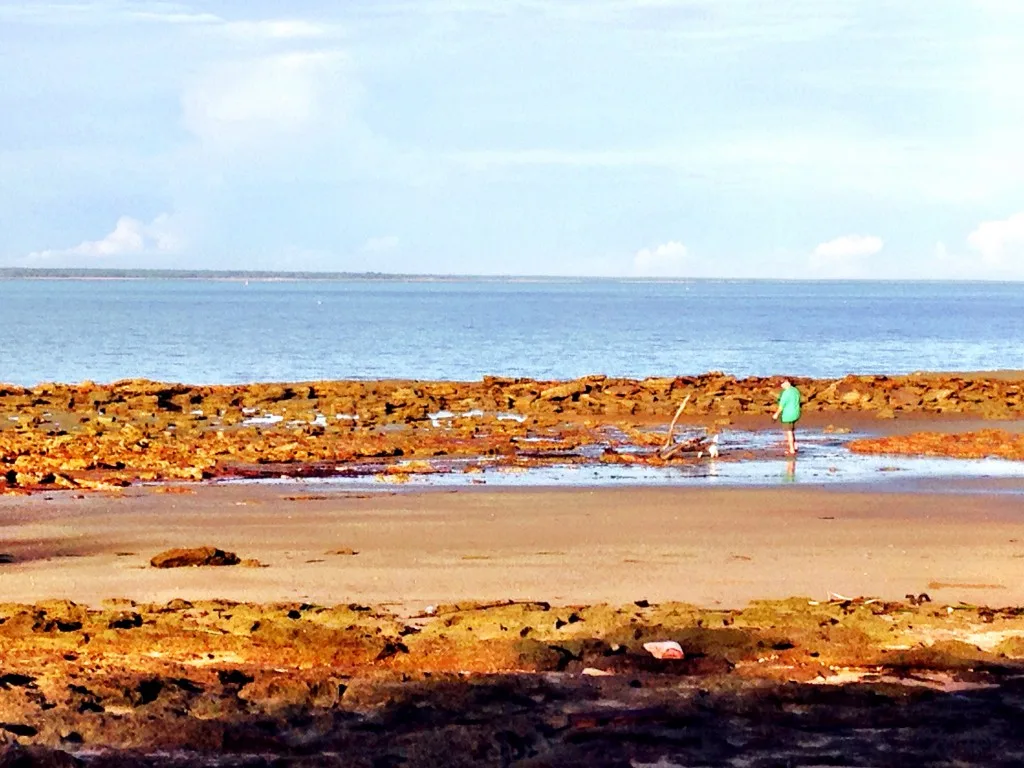
Pete and little Westie at low tide, Fannie Bay

Green oasis at the Darwin Botanical Gardens in Parap
But it wasn’t always this peaceful in Darwin. Lately, the distant thunder has evoked thoughts of earlier times. Seventy-some years ago, Darwin was a very strategic target. Thunder coming from the skies was because of war.
In Parap there was a military airfield located a few blocks from the house where we stay. And further down the coastal street where we park to access the beach is East Point, which still has a defensive pillbox structure reminiscent of those that remain at the D-Day sites in Normandy.

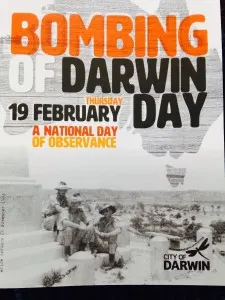 Every February 19th, Australia holds a National Day of Observance for Darwin. This year, services on the City Esplanade were appropriately somber and moving. In one of two prayers, Chaplain Richard Quadrio, RAN, pled God’s blessing on the Australian Defense Force. Remarkably, we thought, his prayer included another request: for guidance and the ability to properly discern potential threats in the future. His high emphasis on evaluating potential threats appropriately made us want to know more.
Every February 19th, Australia holds a National Day of Observance for Darwin. This year, services on the City Esplanade were appropriately somber and moving. In one of two prayers, Chaplain Richard Quadrio, RAN, pled God’s blessing on the Australian Defense Force. Remarkably, we thought, his prayer included another request: for guidance and the ability to properly discern potential threats in the future. His high emphasis on evaluating potential threats appropriately made us want to know more.
On the morning of February 19th, 1942, bombers from a strike force led by the same Japanese commander who had planned and led the attack on Pearl Harbor came in two groups. The first wave, lasting 40 minutes, targeted warships and port facilities, including Darwin’s only hospital. The second claimed heavy damage in a 25 minute sortie aimed at the Royal Australian Air Force facilities near where we live now.
By day’s end, twenty aircraft were hit, eight ships in the harbor were sunk, including the USS Peary (with a loss of more than 100 American lives), and “most civil and military facilities in Darwin were destroyed.”
The result was chaos. Half of Darwin’s population fled 100 km south to the Adelaide River to board the train to other provinces. More than 300 servicemen at the RAAF station deserted. There was widespread looting and disorder. Because Singapore had fallen to the Japanese just days earlier, the Australian government wanted to downplay the situation to ward off national panic. They announced only 17 casualties, when the reality was 14 times higher. Embarrassed, the government suppressed reports of the resultant breakdown in civil order and defense response as well.
But the truth emerged, even if it took decades to do so. By virtually all accounts, facilities in Darwin were under-defended. The reasons for this are troubling. Australia had been officially at war with Japan since Great Britain’s declaration against the Axis. In retrospect, the lack of preparedness seems either an inconceivable miscalculation or a willful denial of threat. Oh, so very familiar to us, from a nation caught by surprise a short ten weeks earlier at Pearl Harbor.
Japanese aggression in the Pacific had moved ominously forward throughout the 1930’s. Plans for national defense allegedly drafted by Prime Minister Robert Menzies had supposedly called for the establishment of the Brisbane Line, stretching from Brisbane in the east to Perth in the west. Menzies had served with a previous pro-Appeasement administration and he had also famously visited Germany in 1938, declaring he was prepared to “give Hitler the benefit of the doubt.”
The political opposition maintained the Menzies government intended the Brisbane Line to be a position behind which the Australian Army would fall back. This would be the strategic defense should the Japanese invade by land. In effect, the plan would have conceded the northern half of Australia’s land mass to the enemy. American General Douglas MacArthur fueled oppositional claims with a reference to the Brisbane Line in the press and other mentions. While the existence of this plan remains in great dispute, there is widespread belief that its attribution contributed to the collapse of the Menzies government in mid-1941. (He would return for a second term in the mid-1950’s.)
With the Curtin government in place only four months prior to the attack, there was little time to get up to speed. In retrospect, Menzies’ extended stay in Great Britain at the beginning of 1941 (where some said he intended to pursue a political career which may have even included an attempt to replace Churchill) might be viewed as somewhat of an abdication. Preoccupied as the acting government and parties may have been in forcing Menzies’ removal by August, 1941, there appears to have been a stunning lack of preparation. Australia just wasn’t ready to stem Japanese aggression and circumvent potential harm in the months leading up to the attack.
By Christmas, 1941, the majority of white Australian women and children had been evacuated from Darwin. Aboriginal women and children were not. While there were many Allied personnel stationed in Darwin, and a sizable Allied fleet in the vicinity, defensive measures appear to have been haphazard. Compounding defense efforts was a dispute between Curtin and Winston Churchill over British troop allocations in reciprocity for Australia’s presence in the European theater.
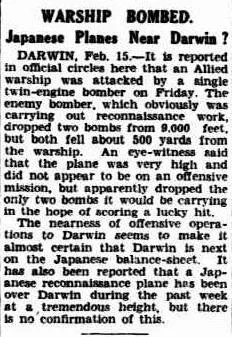 Closer rumblings indicated a storm was brewing and closing in: On New Years Day, 1942, a Japanese submarine was observed in Darwin Harbor. On January 20th, a Japanese sub was sunk by the Australian navy 80 km from Darwin. On the 28th, Japanese reconnaissance planes flew 3 km from Darwin center.
Closer rumblings indicated a storm was brewing and closing in: On New Years Day, 1942, a Japanese submarine was observed in Darwin Harbor. On January 20th, a Japanese sub was sunk by the Australian navy 80 km from Darwin. On the 28th, Japanese reconnaissance planes flew 3 km from Darwin center.
In the program for this year’s commemorative events, interview excerpts from a member of Darwin’s defense unit, William Thomas Dedman, OAM, indicated British Inspector General E. K. Squires did call for strategic placements in the Northern Territory and Queensland. However, the only one to be formed was the Darwin Mobile Force. This army unit consisted of 256 individuals who engaged in a variety of activities: road building, training, and guard duties. In Dedman’s view, there appeared to be little sense of urgency:
“Despite all the activity in Darwin, there were never any thoughts of Darwin being bombed. I can remember the day of that first raid when we saw the planes coming overhead, we thought they were the Americans coming to defend us. . . When that first raid occurred, if it had been followed up with an armed troop landing, I feel sure it would have been successful. We would have been lucky to possess one belt of ammunition between us at the oil tanks on that day. There would have been little hope of surviving and most of us would have been killed or captured.”
We headed over to Defense of Darwin Experience in East Point, an impressive installation with interactive elements designed to give the visitor historical background and first person insights. Its location is on the site of former defensive positions. When you’re done with the museum exhibits and theatre in the round experience, you can wander outside amongst a collection of vintage materiel arranged around the old concrete gun placements and bunkers.
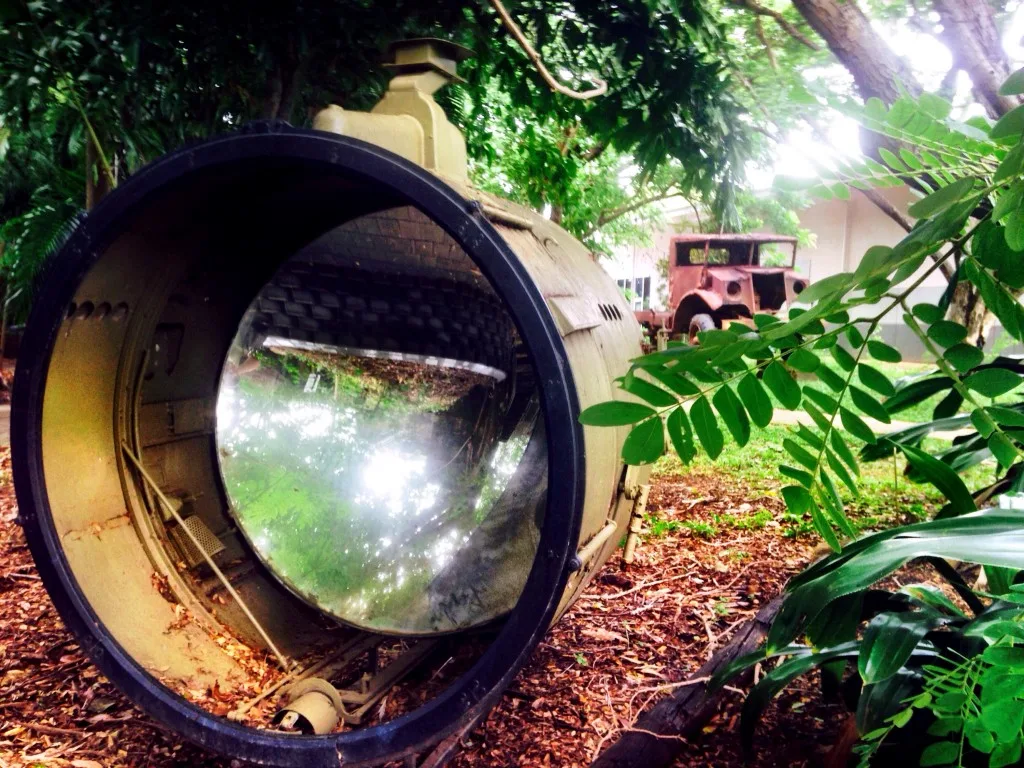
Searchlight and WWII vehicle on the grounds of Defense of Darwin Experience
Defense of Darwin’s exhibit maintains the aftermath of the attacks was more orderly: “Looting certainly occurred; however, the majority of it was sanctioned by authorities. Necessities such as food, furniture , and clothing were requisitioned by the military to provide the basics” for defenders remaining in Darwin. “Few owners ever saw their belongings again and the compensation offered was a fraction of the value of the goods.”
Contradicting itself somewhat, Defense of Darwin’s narrative on the Lowe Commission reports: “The Northern Territory Administrator, Aubrey Abbott, took great exception to the Commission’s findings as they did not paint his leadership in a positive light. . . [M]ajor issues, including poor coordination between civilian and military authorities, delays in giving warning of the impending raids, and the lack of leadership in the aftermath of the raids were all highlighted.”
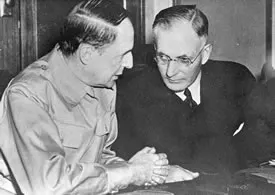
General MacArthur and Prime Minister Curtin Photo: naa.gov.au
According to governmental archives, it was widely believed that the Darwin attacks were the vanguard of a land invasion. But the real Japanese intention was to disrupt any Allied use of Darwin as a base from which to launch counter-offensives. Nevertheless, this initial bombing of Darwin, like the Japanese attack on Pearl Harbor, was a huge wake-up call. MacArthur was appointed head of Australian defense forces in March, 1942:
“General MacArthur was ordered by President Franklin Roosevelt to organise Pacific defense with Australia. . .Curtin agreed to Australian forces coming under the overall command of MacArthur and passed the responsibility for strategic decision-making onto MacArthur who was titled Supreme Commander of the South West Pacific. From MacArthur’s point of view this was a workable alliance – he told Curtin to ‘take care of the rear and I will handle the front’.”
Over the next two years, Darwin would be bombed or raided 46 times. The Northern Territory would sustain 64 attacks in all during 1942-1943.
Defense of Darwin’s narrative summarizes:
“In the years since, talk of cover-ups and censorship around the Darwin raids have [sic?] been rife. News of the initial attacks reached the southern papers very quickly, and made the front pages the following day. The release of the Lowe Commission report also made all the major papers, but rarely the front-page headlines. Whether this was the result of censorship, a cover-up or the fact that it was simply ‘old news’ at a time when Australian soldiers, sailors and pilots were involved in numerous conflicts around the world, is open to conjecture.”
One of the most moving aspects of the Esplanade ceremonies was the small number of survivors, veterans adorned with service medals and evacuees, who came to pay tribute to those who were lost. Elderly and many quite frail, it was a reminder that their numbers will grow smaller with each passing year, their legacy committed to memory. The distance of time will soften the vivid reality each of these participants carries; even now we are left with a faded glimpse. It becomes more difficult to imagine, let alone make application and conclusions which might be relevant to our experience today.
Going about your daily business in Darwin, if you even think about the outside world at all, you get the sense of looking at it though the large end of a telescope. It is far, far away. Bad stuff happens, to be sure, but in other places. Not here. Peaceful views from the Dudley Point overlook across Fannie Bay, where searchlights were installed and a boom was laid across the harbor to interrupt submarine traffic, embody this impression.
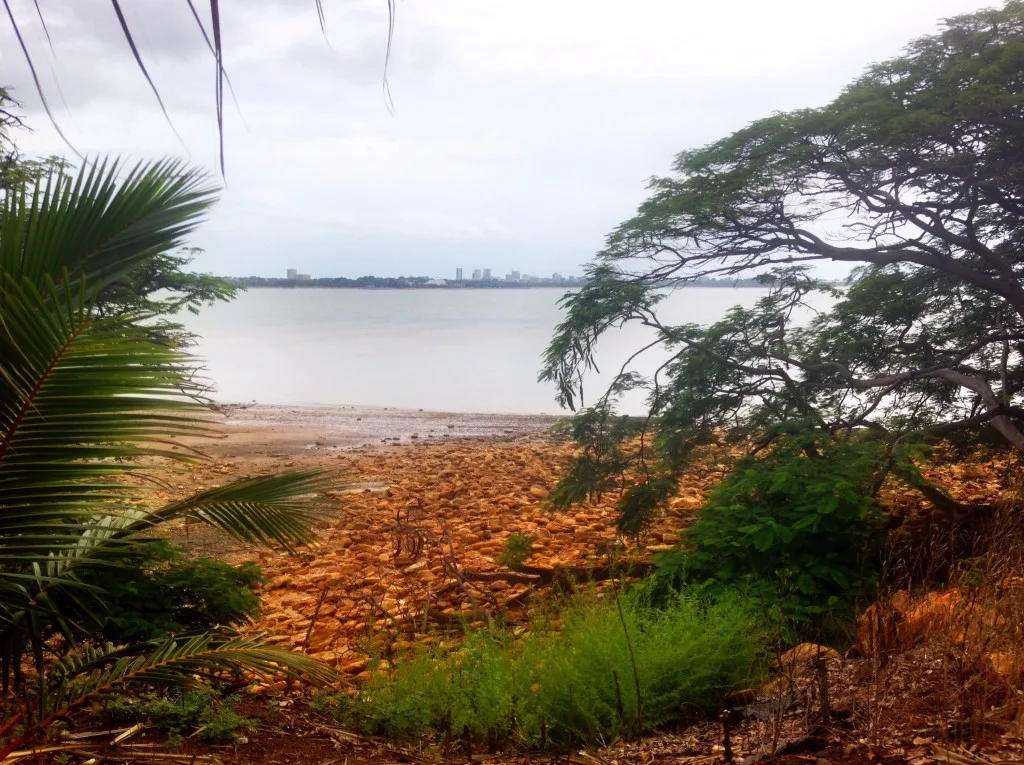
View from Dudley Point, the southern promontory of East Point, across Fannie Bay over to the City of Darwin
With all this to reflect upon, it can be very easy to understand why Japanese aggression was underestimated or even dismissed. But I think we owe it to the dwindling numbers of survivors, as the Chaplain so fervently prayed, to use what we learned from the bombing of Darwin. There are so many modern-day parallels in fanaticism, military and paramilitary buildup, threats and posturing, levels of barbarism and mayhem.
Here in Darwin, far away from everywhere, frequent distant thunder hints of a storm on the horizon. You can always count on the fact that occasionally one will arrive. Just like long ago.
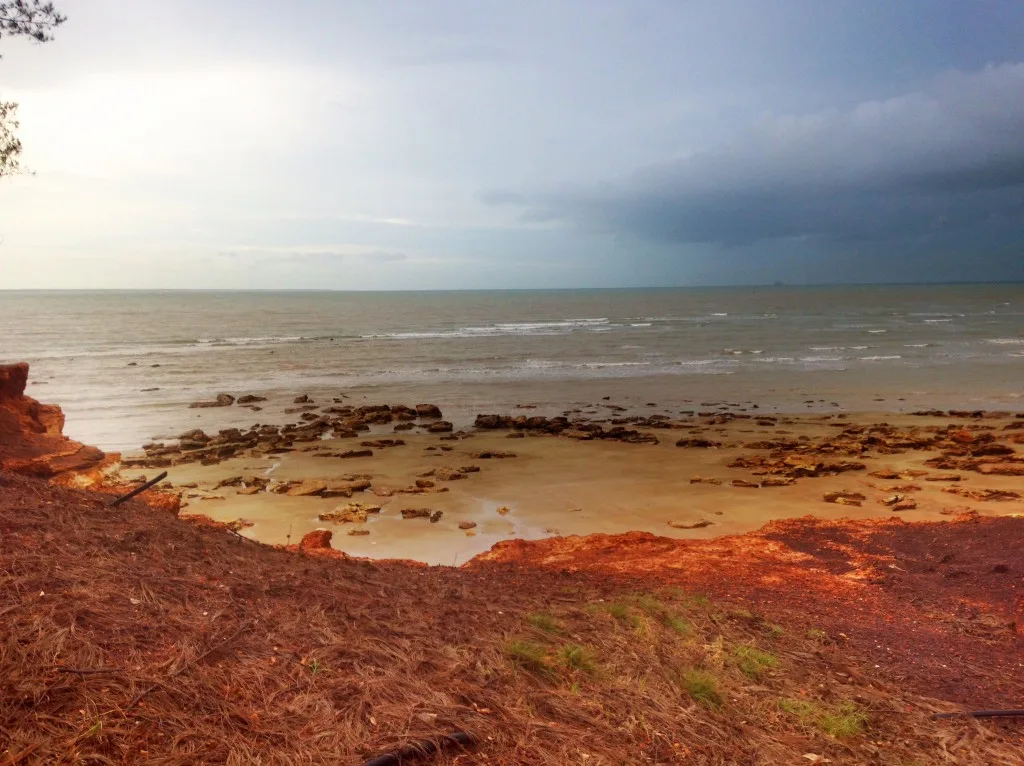
A storm brews off Dudley Point, headed for East Point
Additional information: Defense of Darwin Experience is open 7 days a week from 11 am to 5 pm, located at 5434 Alec Fong Lim Drive, East Point, Darwin. Closed only on Christmas Day, Boxing Day, New Years Day and Good Friday. Admission fees apply and free parking is abundant. Additional military heritage sites are dispersed around Darwin and can be visited within easy driving distance. An ongoing formal Roll of Honour to commemorate the dead from February 19th, 1942 has been compiled with the assistance of history groups, families, and archivists. There is free (quite slow and variable signal) wi-fi on site and a Defense of Darwin iPhone app which can be downloaded to enhance your visit. Annual remembrance services are held each February 19th on the Darwin Esplanade waterfront, including a re-enactment and flyover by vintage aircraft.
Tips for Trip Success
Book Your Flight
Find an inexpensive flight by using Kayak, a favorite of ours because it regularly returns less expensive flight options from a variety of airlines.
Book Your Hotel or Special Accommodation
We are big fans of Booking.com. We like their review system and photos. If we want to see more reviews and additional booking options, we go to Expedia.
You Need Travel Insurance!
Good travel insurance means having total peace of mind. Travel insurance protects you when your medical insurance often will not and better than what you get from your credit card. It will provide comprehensive coverage should you need medical treatment or return to the United States, compensation for trip interruption, baggage loss, and other situations.Find the Perfect Insurance Plan for Your Trip
PassingThru is a participant in the Amazon Services LLC Associates Program. As an Amazon Associate I earn from qualifying purchases.
To view PassingThru’s privacy policy, click here.

Rosalva B.
Tuesday 2nd of June 2015
Thank you Betsy!
The article is incredible! I had no idea what happened in Darwin during the WW2! I am from Europe and here we don't study about what happened outside of Europe! This is really interesting! Darwin is definitely a very special place that I'd love to visit! The nature there is absolutely stunning!
Greetings! :)
Betsy Wuebker
Tuesday 2nd of June 2015
Hi Rosalva - I think this is a common theme - Euro-centric histories of WWII - and we should all have a talk with the history book authors. Glad you enjoyed the article.
Revati
Tuesday 3rd of March 2015
Always wanted to go to Darwin. But it has somehow always eluded us. And now that we know so much of its story, definitely made it more intriguing.
Betsy Wuebker
Tuesday 3rd of March 2015
Hi Revati - Yes, it's one little piece in a quite fascinating history. Thanks!
Megsy
Monday 2nd of March 2015
History lesson included! It's often an overlooked fact but yes, Southeast Asia wasn't the only area affected by the Japanese campaign. Awesome photos! Great post.
Betsy Wuebker
Monday 2nd of March 2015
Hi Megsy - Yes, indeed. Never a bad idea to brush up on history. :)
alison @GreenWithRenvy
Sunday 1st of March 2015
Great lesson of history I knew very little about Betsy. We learn such a US centered version of history here in school. My eyes have been opened through travel and I think that exposure is one of travel's greatest benefits. Better understanding of cultures and history can only help with relationships around the world.
Betsy Wuebker
Sunday 1st of March 2015
Hi Alison - I totally agree how eye-opening travel is, and how important the understanding we gain is. We're all human beings with more similarities than differences. Thanks.
Adventurous Journeys
Sunday 1st of March 2015
When I think of WW2 I only think of Europe, but I guess this is beacause of our education programme. Thanks god we have blogs nowadays!
Betsy Wuebker
Monday 2nd of March 2015
Hi Adventurous Journeys - Yes, it makes you wonder who decided to leave so much out?